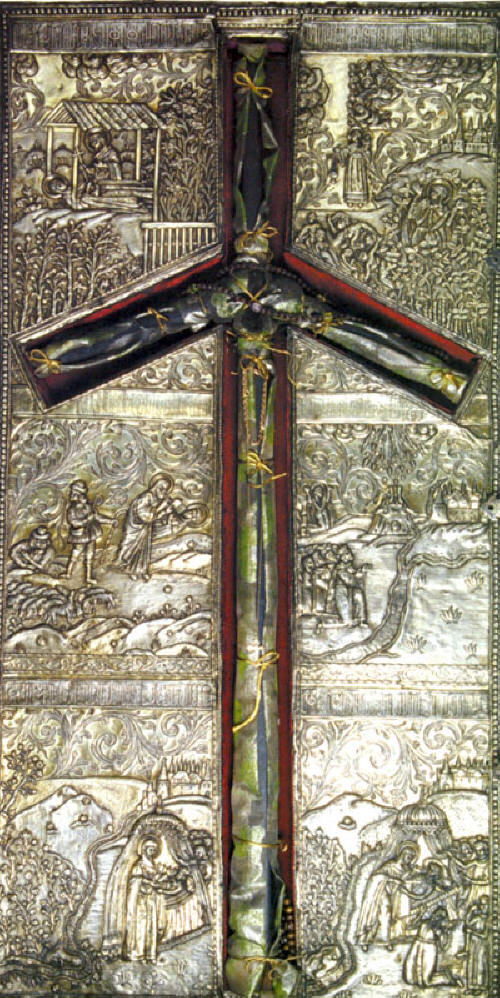

See also:
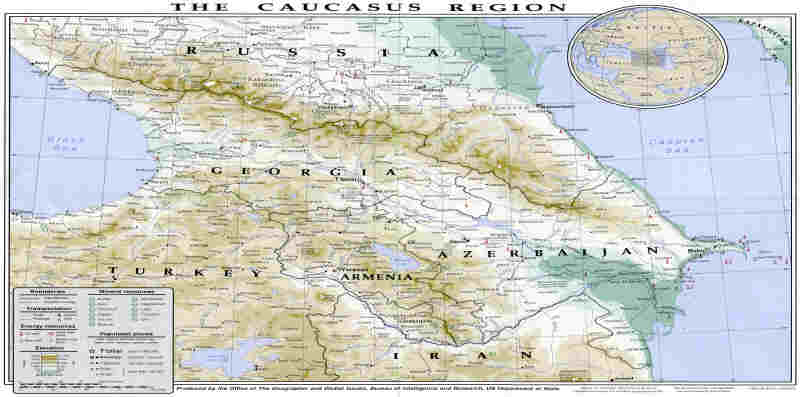
The Kaukasus region 1994 - large map ![]()
This summer I was blessed to be able to visit my wife's family in one of the world's oldest Orthodox countries, Georgia. Georgia is a country that is often overlooked or only very briefly dealt with in English-language publications about Orthodoxy, but it is a country that can teach us a great deal about our Faith. It is a country that has had to fight for its Faith almost from the time of its conversion. But during the course of its troubled history, the Church in Georgia has managed to keep its traditions, Church music and buildings of great beauty and grace.
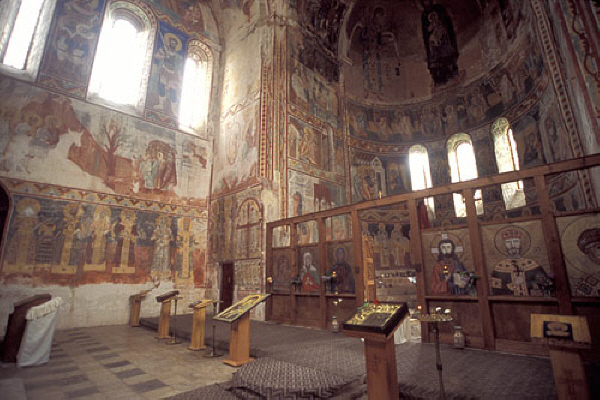
Interior of the church of Gelati, Kutaisi in Georgia. Source: www.sacredsites.com
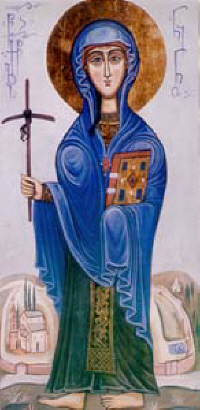 St Nino, a poor girl from Cappadocia, converted Georgia in the 4th century. This is of
course the region from where St George came, giving his name to the country. Both saints remain extremely important to Georgians. Call either name in a public place and large
numbers of people will turn to see if it is they that you have called.
St Nino, a poor girl from Cappadocia, converted Georgia in the 4th century. This is of
course the region from where St George came, giving his name to the country. Both saints remain extremely important to Georgians. Call either name in a public place and large
numbers of people will turn to see if it is they that you have called.
In addition to these saints, St Andrew, St Simon the Caananite and St Matthias preached in Georgia.
Sadly, Georgia has always had to fight for Orthodoxy, principally against Moslem attackers such as Tamarlane and Shah Jalal Uddin. The latter martyred 100,000 Georgians in 1226, after they had refused to renounce Orthodoxy and trample and spit on icons. Of course, later, Georgia also suffered under Communism. In 1989 autocephaly was recovered by the Georgian Orthodox Church from the Russian Church. Since independence, the Church has rapidly moved to repair some of the damage inflicted by Communism.
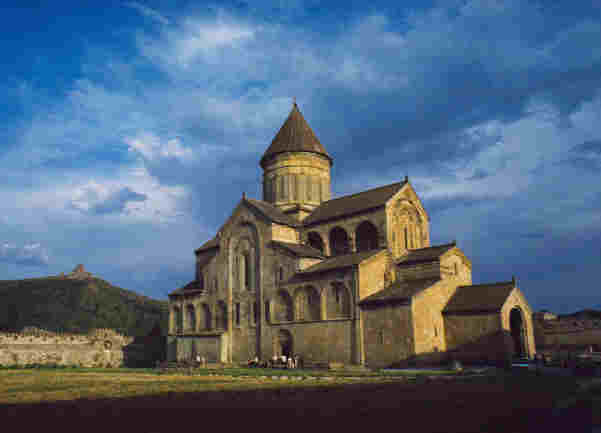
Svetitskhoveli Cathedral, built over the Robe of the Lord
Perhaps the most important centre of Orthodoxy in Georgia can be found in the town of Mtskheta, not far from the capital, Tbilisi. Along with several monasteries and convents, the Svetitskhoveli Cathedral and Jvari Monastery are of principal interest to Orthodox.
Svetitskhoveli means 'living pillar' and is perhaps the most sacred site in Georgia. It is built over the grave of Sidonia, whose brother Elias bought Christ's robe in Jerusalem from a Roman soldier after converting to Christianity. When he presented the robe to his sister, she immediately died because of the overwhelming emotions caused by contact with something so sacred. A huge cedar of Lebanon tree grew on the site. It was later felled by Georgia's first Christian King in order to build the country's first Cathedral. Seven columns for the new Cathedral were made from the cedar, but the seventh could not be put in place. This was because it floated above the site until St Nino's prayers brought it into place, hence the name 'living pillar'.

St. Nino (St.
Nina) of Georgia and The miracle of the Life-giving Pillar
The Cathedral is overlooked by Jvari (Cross) Monastery, sited on a cliff above the town. The Monastery is so named because it contains a wooden cross raised up on the site by St Nino herself.
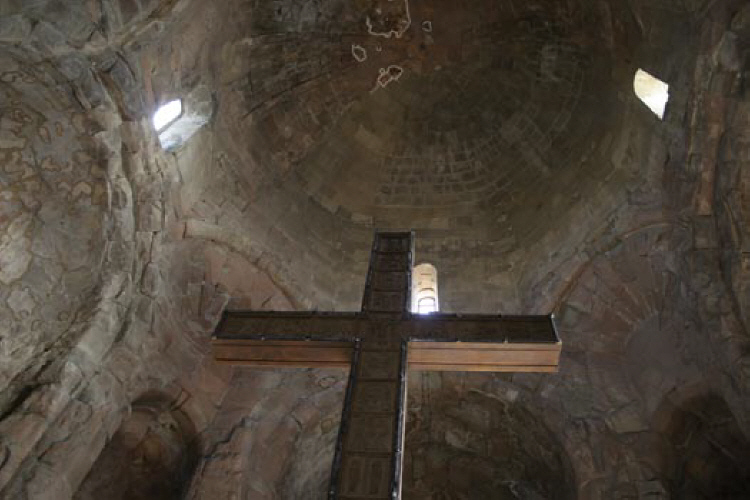
It is spectacularly situated, but this summer what was even more impressive for me than the location, was the sight of the monks walking for miles across mountainous terrain to attend to the spiritual needs of people in remote areas. They demonstrated no sign of tiredness, despite temperatures in the mid-30s and their thick monastic clothing.
With reference to these two sites, words cannot really do the frescoes and icons justice. Some have been restored many times after destructive Moslem attacks and are sites of great peace and grace. All Orthodox who have the opportunity ought to visit Mtskheta.
We were blessed to be in Georgia for the Feasts of the Transfiguration and the Dormition of the Mother of God, on the 19 and 28 August, new style. The services demonstrated how far Orthodoxy has recovered since the fall of Communism. Before the feast-days it was particularly impressive to see how many people were confessing. Priests faced long queues of people waiting to confess, which partly accounts for the length of the services on the feast-days themselves. Before the services began there were large numbers of people underway in Tbilisi. This is because the Georgians tend to favour a particular church that may not necessarily be the nearest to their home. It is advisable to arrive early in order to get inside.
The fact is that, despite the number and size of churches, there is simply not enough room for all the Orthodox who wish to worship. Many people have to listen to the service outside the church. It is just as well that there are no pews in the Orthodox Church, as they would make the space problem even worse.
Although I do not understand much Georgian, the services naturally follow the pattern of the liturgy of the other Orthodox Churches we in Western Europe are used to. Communion takes a great deal of time however, purely because of the sheer number of people who have prepared to receive the Holy Gifts. The sermons are much longer than those to which we are used in the West, they are usually between one and one and a half hours long. Nevertheless, they are listened to with great reverence, and sometimes recorded for rebroadcast on the Georgian Patriarchate's radio station.
I would like to make particular mention of an icon of the Mother of God in the Church of St Peter and St Paul in Tbilisi. For me it was a pilgrimage to see this icon that turned my steps towards Orthodoxy. This icon was painted in 1994 after a pilgrimage to Cappadocia by some of the church's parishoners. There they found an old fresco in a disused church of the Mother of God, depicting her with a remote air, gazing though space and time, from the present to the future. An adaptation of this icon was painted by the church's iconographer onto an old church window shutter. This icon has already proved to be wonder-working; its first miracle was the healing of an atheist.
My wife often wears a small copy of this icon and it was this icon which prompted me to ask her about the Orthodox Church. One can discuss the meaning of an Englishman finding himself venerating an icon as an Orthodox Christian in Georgia a little under two years after his first contact with the Orthodox Church, but I believe this is another testament to this icon's power. As my wife's cousin is an aspiring priest and reader, I was privileged enough to venerate the icon through one of the side doors in the iconostasis. Father Archil, St Peter and St Paul's priest, told me how thrilled he was that an English Orthodox had visited his church and that the Orthodox Church in England is gaining more English converts. He also gave me a vial of myrrh which came from the church's icon of the Mother of God and from holy items in Jerusalem. This icon is called 'You are a vineyard', which is also the title of perhaps the most beautiful hymn I have heard in the Orthodox Church and one of the Georgian Church's greatest musical treasures.
Against all the odds, and so many enemies, the Georgians have kept their Faith and Church intact. Polyphonic Georgian Church music has also been kept, giving services great beauty. As elsewhere in the Orthodox world, many people cross themselves in public transport, as their bus passes a church. However, the Church now faces a newer, more insidious threat. Many American sects, the Jehovah's Witnesses in particular, are buying Orthodox souls with their dollars. Georgian priests feel obliged to remind their congregations that ours is the One True Church, and that modern sects promising financial gain are not to be trusted. That Western Europeans are turning back to Orthodoxy strengthens this important message, which is sometimes made difficult by the terrible poverty in which many people, particularly the refugees from Abkhazia, must live. Father Archil asked me to tell the people in North-West Europe about the people in South-East Europe. I hope I will not be the last English Orthodox to visit his church and its marvellous, wonder-working icon.
Guy Wilson
www.orthodoxengland.org.uk

The Grapevine Cross also known as the Georgian cross or Saint Nino’s cross.
Photo Paata Vardanashvili
Reposed 335 AD; commemorated January 14/27
 The virgin Nino of Cappadocia was a relative of Great-martyr George and the only daughter of a widely respected and
honorable couple. Her father was a Roman army chief by the name of Zabulon, and her mother, Sosana, was the sister of Patriarch Juvenal of Jerusalem. When Nino reached the age of
twelve, her parents sold all their possessions and moved to Jerusalem. Soon after, Nino’s father was tonsured a monk. He bid farewell to his family and went to labor in the
wilderness of the Jordan.
The virgin Nino of Cappadocia was a relative of Great-martyr George and the only daughter of a widely respected and
honorable couple. Her father was a Roman army chief by the name of Zabulon, and her mother, Sosana, was the sister of Patriarch Juvenal of Jerusalem. When Nino reached the age of
twelve, her parents sold all their possessions and moved to Jerusalem. Soon after, Nino’s father was tonsured a monk. He bid farewell to his family and went to labor in the
wilderness of the Jordan.
After Sosana had been separated from her husband, Patriarch Juvenal ordained her a deaconess. She left her daughter Nino in the care of an old woman, Sara Niaphor, who raised her in the Christian Faith and related to her the stories of Christ’s life and His suffering on earth. It was from Sara that Nino learned how Christ’s Robe had arrived in Georgia, a country of pagans.
Soon Nino began to pray fervently to the Theotokos, asking for her blessing to travel to Georgia and be made worthy to venerate the Sacred Robe that she had woven for her beloved Son. The Most Holy Virgin heard her prayers and appeared to Nino in a dream, saying, “Go to the country that was assigned to me by lot and preach the Gospel of our Lord Jesus Christ. He will send down His grace upon you and I will be your protector.”
But the blessed Nino was overwhelmed at the thought of such a great responsibility and answered, “How can I, a fragile woman, perform such a momentous task, and how can I believe that this vision is real?” In response, the Most Holy Theotokos presented her with a cross of grapevines and proclaimed, “Receive this cross as a shield against visible and invisible enemies!”
When she awoke, Nino was holding the cross in her hands. She dampened it with tears of rejoicing and tied it securely with strands of her own hair. (According to another source, the Theotokos bound the grapevine cross with strands of her own hair.)
Nino related the vision to her uncle, Patriarch Juvenal, and revealed to him her desire to preach the Gospel in Georgia. Juvenal led her in front of the Royal Doors, laid his hands on her, and prayed, “O Lord, God of Eternity, I beseech Thee on behalf of my orphaned niece: Grant that, according to Thy will, she may go to preach and proclaim Thy Holy Resurrection. O Christ God, be Thou to her a guide, a refuge, and a spiritual father. And as Thou didst enlighten the Apostles and all those who feared Thy name, do Thou also enlighten her with the wisdom to proclaim Thy glad tidings.”
When Nino arrived in Rome, she met and baptized the princess Rhipsimia and her nurse, Gaiana. At that time the Roman emperor was Diocletian, a ruler infamous for persecuting Christians. Diocletian (284–305) fell in love with Rhipsimia and resolved to marry her, but St. Nino, Rhipsimia, Gaiana, and fifty other virgins escaped to Armenia. The furious Diocletian ordered his soldiers to follow them and sent a messenger to Tiridates, the Armenian king (286–344), to put him on guard.
King Tiridates located the women and, following Diocletian’s example, was charmed by Rhipsimia’s beauty and resolved to marry her. But St. Rhipsimia would not consent to wed him, and in his rage the king had her tortured to death with Gaiana and the fifty other virgins. St. Nino, however, was being prepared for a different, greater task, and she succeeded in escaping King Tiridates’ persecutions by hiding among some rose bushes.
When she finally arrived in Georgia, St. Nino was greeted by a group of Mtskhetan shepherds near Lake Paravani, and she received a blessing from God to preach to the pagans of this region.
With the help of her acquaintances St. Nino soon reached the city of Urbnisi. She remained there a month, then traveled to Mtskheta with a group of Georgians who were making a pilgrimage to venerate the pagan idol Armazi. There she watched with great sadness as the Georgian people trembled before the idols. She was exceedingly sorrowful and prayed to the Lord, “O Lord, send down Thy mercy upon this nation …that all nations may glorify Thee alone, the One True God, through Thy Son, Jesus Christ.”
Suddenly a violent wind began to blow and hail fell from the sky, shattering the pagan statues. The terrified worshipers fled, scattering across the city.
St. Nino made her home beneath a bramble bush in the garden of the king, with the family of the royal gardener. The gardener and his wife were childless, but through St. Nino’s prayers God granted them a child. The couple rejoiced exceedingly, declared Christ to be the True God, and became disciples of St. Nino. Wherever St. Nino went, those who heard her preach converted to the Christian Faith in great numbers. St. Nino even healed the terminally ill Queen Nana after she declared Christ to be the True God.
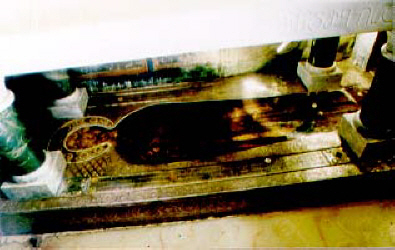 King Mirian, a pagan, was not at all pleased with the great impression St. Nino’s preaching had made on the
Georgian nation. One day while he was out hunting, he resolved to kill all those who followed Christ.
King Mirian, a pagan, was not at all pleased with the great impression St. Nino’s preaching had made on the
Georgian nation. One day while he was out hunting, he resolved to kill all those who followed Christ.
According to his wicked scheme, even his wife, Queen Nana, would face death for failing to renounce the Christian Faith. But in the midst of the hunt, it suddenly became very dark. All alone, King Mirian became greatly afraid and prayed in vain for the help of the pagan gods. When his prayers went unanswered, he finally lost hope and, miraculously, he turned to Christ: “God of Nino, illumine this night for me and guide my footsteps, and I will declare Thy Holy Name. I will erect a cross and venerate it and I will construct for Thee a temple. I vow to be obedient to Nino and to the Faith of the Roman people!”
Suddenly the night was transfigured, the sun shone radiantly, and KingMirian gave great thanks to the Creator. When he returned to the city, he immediately informed St. Nino of his decision. As a result of the unceasing labors of Equal-to-the-Apostles Nino, Georgia was established as a nation solidly rooted in the Christian Faith.
St. Nino reposed in the village of Bodbe in eastern Georgia and, according to her will, she was buried in the place where she took her last breath. King Mirian later erected a church in honor of St. George over her grave.
Source: www.oca.org
PRAYER TO THE HOLY, EQUAL OF THE APOSTLES, NINA
O all-praised and wonderful equal of the Apostles Nina. truly great adornment of the Orthodox Church and great boast of the people of Iberia, thou who didst enlighten the whole land of Georgia with the divine teachings, and with apostolic deeds didst defeat the enemy of our salvation, by labour and prayer thou didst plant there a vineyard of Christ and increase its fruit many-fold Celebrating thy holy memory, we approach thy holy image and with reverence kiss the miracle-working cross, the highly praised gift to thee from the Mother of God, which thou hast encircled with thy clear hair, and tenderly ask thee, as our constant intercessor: protect us from all evil and sorrows, and from the opponent of piety guard thy flock which hath been saved by thee, and beseech our all-good God and Saviour, before Whom thou art now standing, that He may grant us peace and many years, and that the Lord may bring us into His kingdom, where all the saints praise His holy name, both now and ever and unto the ages of ages. Amen.
of Tyrannius Rufinus (340/345 – 410)
(Book I, chapter 10: on the Conversion of the Iberian People, brought about by a captive woman)
At that time also the Iberian nation, who live in the clime of Pontus, accepted the laws of God's word and faith in the kingdom of heaven. This so excellent deed was brought about by a certain captive woman who had fallen among them, and who led a life of faith and complete sobriety and virtue, and throughout the days and nights unceasingly offered up prayers to God. The very novelty of this thing began to amaze the barbarians, and they diligently Inquired what it meant. She told them simply the truth of the matter, namely that she was wont thus to worship Christ her God. The strangeness of this name seemed to the barbarians the most astonishing feature of the whole business. Xs often happens, however, her very persistence aroused among the womenfolk a certain curiosity to see whether such devotion might not win some reward.
It is said to be a custom among them that if a child falls ill, it is carried round by its mother to each individual household, so that if anyone knows of some trustworthy remedy, he may administer it to the sufferer. Accordingly, when a certain Woman had carried her ailing child to everyone, as the custom was, but without finding any cure in all the homes she had visited, she came at last to the captive Woman so that she too might declare anything she knew of. The captive woman affirmed that she knew of no human remedy, but assured the mother that her God Christ, whom she worshipped, could grant the child that deliverance of which men had lost hope. Placing the infant on her hair cloak and furthermore offering up a prayer to the Lord, the captive woman then gave back the child cured to its mother.
The report of this spread to many, and the renown of the marvellous deed reached the ears of the queen who, being afflicted by some very grave bodily complaint, was in the greatest desperation. She asked for the captive woman to be brought to her. The latter, however, declined to go, lest she should seem to diverge from the retiring Way of life fitting to her sex. Then the queen commanded them to carry her to the captive's cell. After laying her likewise on her hair cloak and calling on Christ's name, the captive woman raised her up immediately after the prayer in good health and spirits. She taught the queen that Christ, Son of God Almighty, was the Deity who had bestowed this cure on her, and that she should invoke Him, whom she ought to acknowledge as the source of her life and health. For it is He who distributes kingdoms to kings, and life to mortal men. And the queen, returning joyfully homewards, in answer to her husband's enquiry revealed the source of her sudden restoration to health. But when in his joy at his wife's recovery, he ordered presents to be sent to the woman, the queen said, "O King, the captive woman prizes none of these things. She rejects gold, despises silver and nourishes herself by fasting as if by food. The only way in Which we can reward her is by worshipping that God Christ who cured me according to her prayer."
At that time, the king paid no attention to this and put the matter off, although his wife often recalled it to his mind. At Length one day while he was hunting in the forest with his retainers, the light of day was clouded over with dense murk and disappeared in the horror of pitch-black night, making it impossible to proceed. His companions dispersed in various directions and lost their way, and he remained alone enveloped in impenetrable gloom, without knowing what to do or Where to turn. Suddenly his spirit, tormented by despair of being rescued, was lit up by a thought: "If indeed that Christ whom the Captive had preached to his Wife was God, then let Him now deliver him from this darkness, that he too might forsake all other gods to worship Him." And forthwith, as soon as he had made this vow in thought alone, and before he had time to express it in words, the light of day was restored to the world, and led the king unharmed to the city.
Revealing immediately to the queen What had occurred, he summons the captive w Oman, bidding her instruct him in the ritual of worship, and affirming that he would from now on venerate no other god but Christ. Tile captive woman appears, and preaches Christ the Lord, expounding the rites of prayer and the form of worship, in so far as these could properly he known to a woman. In addition, she tells them to build a church, and describes its shape.
The king accordingly Summoned together all the folk of his nation, and related the events which had happened to him and the queen From the very beginning. He instructed them in the faith and, albeit himself not yet initiated into the sacraments, became the apostle of his own nation. The men believed thanks to the king, the women thanks to the queen, and with a single mind they set to work to build a church. The surrounding walls were quickly erected, and the time came to set up the columns. When the first and second pillars had been raised, and they proceeded to lift the third, they employed all forms of machinery and the strength of oxen and men, but when it had been elevated to a slanting angle, it proved impossible by any manner of effort to raise it the rest of the way. The redoubled and often repeated efforts of all the men failed to move it from its position, and everyone was reduced to exhaustion. The whole people was seized with astonishment, and the king's resolution began to fail him. Nobody knew what was to be done.
But when at nightfall everyone went away, and both the toilers and their toil fell into repose, the captive woman remained alone on the spot and passed the whole night in prayer. And behold, when the king and all his people arrived full of anxiety in the morning, he saw the column, which so many machines and so many men could not shift, standing upright and freely suspended above its pedestal - not set upon itch but hanging in the air about a foot above. As soon as the whole people witnessed this, they glorified God and began to declare this to he a proof of the truth of the king's faith and the religion of the captive woman. And behold, while they were all paralyzed with amazement, the pillar slowly descended on to its base before their eyes without anyone touching it, and settled in perfect balance. After this! the rest of the columns were erected with such ease that the remainder were all set in place that same day.
After the church had been built with due magnificence, the people were zealously yearning for God's faith. So an embassy is sent on behalf of the entire nation to the Emperor Constantine, in accordance with the captive woman's advice. The foregoing events are related to him, and a petition submitted, requesting that priests be sent to complete the work which God had begun. Sending them on their way amidst rejoicing and ceremony, the Emperor was far more glad at this news than if he had annexed to the Roman Empire peoples and realms unknown.
These happenings were related to us by Bacurius, a most trustworthy man, himself king of that very nation, and commander of the Guards in our court (who was most scrupulous about religion and truth), at the time when he resided with us at Jerusalem on cordial terms, being then in command of the frontiers of Palestine.
The book "LIVES AND LEGENDS OF THE GEORGIAN SAINTS" Selected and Translated from the original texts by DAVID MARSHALL LANG (M.A.,Ph.D. Professor of Caucasian Studies University
of London).
This Electronic material is copyrighted by Besiki Sisauri - MDiv. It may not be modified in any way, but
can be transmitted on electronic BBS systems for the edification of those wishing to know more about the Georgian Orthodox Church.
Виж също: